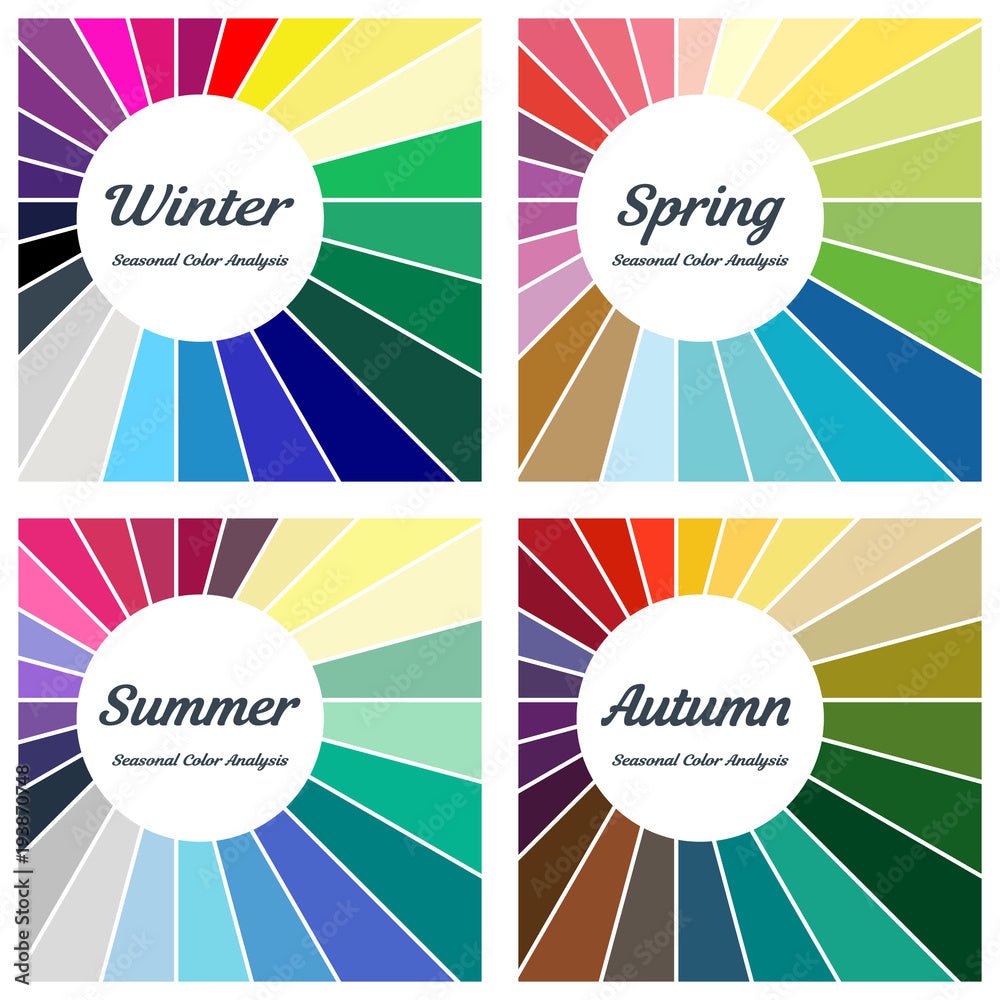
Find Your Seasonal Colour Palette
Share
Discovering Your Seasonal Color Palette: The Ultimate Guide to Finding Your Best Colours
When it comes to personal style, nothing can make a bigger impact than the right color choices. While trends come and go, your personal color palette stays as timeless as your unique features. Finding the right colors that complement your natural beauty can elevate your look, boost your confidence, and even make getting dressed in the morning a little bit easier.
The key to unlocking your most flattering colors lies in understanding your seasonal color profile, which is primarily determined by three important factors: your hair color, skin tone, and eye color. Here’s a breakdown of how to find your perfect seasonal color palette, and how to use those colors to shine in every season!
Step 1: Understanding the Seasonal Colour Theory
The concept of seasonal colour analysis was developed to help people identify which colours work best for them based on their natural features. The theory divides people into four main seasonal categories: Spring, Summer, Autumn, and Winter. Each season has distinct characteristics, and your personal color season will depend on your overall combination of hair colour, skin tone, and eye colour.
Step 2: Identifying Your Seasonal Colour Based on Hair Colour
Your hair colour plays a crucial role in determining your season. Here’s how different shades of hair align with each season:
-
Spring: If you have golden blonde, strawberry blonde, or light auburn hair, you may belong to the Spring season. Spring hair colors are typically warm with a golden or peachy undertone.

-
Summer: Cooler shades like ash blonde, soft brown, and silver hair often fall under the summer category. These colours usually have a neutral to cool undertone, and the hair may appear more muted and soft.

-
Autumn: If your hair has rich, warm tones like chestnut, deep red, or dark brown with golden highlights, you’re likely an Autumn. These shades are warm and earthy, often with copper or gold hints.

-
Winter: For those with deep, dark hair like black, espresso, or cool brown with no warm undertones, you’re likely in the Winter category. Winter hair colour tends to have a strong, cool undertone with no traces of red or gold.

Step 3: Determining Your Seasonal Color Based on Skin Tone
Skin tone is often the most defining feature when determining your seasonal palette. Here’s how to figure out which colours will flatter your complexion:
-
Spring: Spring skin tones are often light to medium with a warm, golden undertone. You may notice a natural warmth to your skin, which pairs beautifully with soft, warm colors like peach, coral, and ivory.

-
Summer: Summer skin tones are usually fair to medium with cool undertones. You might have pale or rosy skin that burns easily in the sun. Summer colours work best with cool, soft hues like pastel blues, lavender, and soft pinks.

-
Autumn: Autumn skin tones typically have warm, golden, or olive undertones. If you tan easily and your skin has a natural golden glow, you’re likely an Autumn. Rich, earthy tones like mustard, rust, and olive green will enhance your complexion.

-
Winter: Winter skin tones can range from fair to deep, but they almost always have cool undertones. You might notice a pink or blue undertone to your skin. Winter palettes thrive with high-contrast colors like deep blues, jewel tones, and stark whites.

Step 4: Finding Your Seasonal Color Based on Eye Color
Your eye colour can also give valuable insight into your seasonal palette. The hue and depth of your eyes play a role in complementing your natural colouring:
-
Spring: People with Spring colouring often have light blue, light green, or warm hazel eyes. Their eyes may sparkle with a clear, bright look that is complemented by soft, light colours like mint green, turquoise, and buttery yellows.

-
Summer: Summer eyes tend to be soft and muted, with shades like gray, soft blue, or pale green. Eyes often have a silvery or cool tone that pairs well with gentle pastels and cool tones like lavender and soft blues.

-
Autumn: Autumn eyes are often deep brown, amber, hazel with golden or green flecks, or rich green. These colours pair beautifully with earthy tones such as burnt orange, terracotta, olive green, and browns.

-
Winter: Winter eyes tend to be very striking, with colours like dark brown, dark blue, deep gray, or emerald green. These colours have a cool, intense quality that is flattered by bold colours such as icy blues, royal purples, and black.

Step 5: Putting It All Together – Your Seasonal Colour Palette
Once you’ve identified your hair colour, skin tone, and eye colour, you can confidently determine which seasonal palette is best for you. Each season has a set of colours that complement the natural tones in your hair, skin, and eyes.
Spring Colour Palette
- Warm, soft, and clear tones like peach, coral, turquoise, soft yellow, and camel.
- Best for those with light, warm features, such as golden blonde hair and warm skin tones.
-


Summer Colour Palette
- Cool, soft pastels like lavender, dusty rose, cool blues, and light gray.
- Ideal for those with fair skin and light hair, with a cool undertone.
-


Autumn Colour Palette
- Rich, earthy tones like deep browns, mustard yellow, terracotta, and burnt orange.
- Great for people with warm, golden undertones in their skin and darker hair.
-


Winter Colour Palette
- Bold, cool colours like black, navy, emerald green, jewel tones, and pure white.
- Suited for those with deep, cool undertones in their skin and hair.
-


Final Tips for Styling Your Seasonal Colours
-
Experiment with Accessories: If you’re not sure about fully committing to a colour, start by incorporating it in accessories like scarves, jewelry, or shoes.

-
Balance with Neutrals: While seasonal colours will give you a base to work from, don't forget to mix in your favorite neutrals to balance your look.

-
Embrace the Season: As the seasons change, you can adapt your colour palette. During warmer months, go for lighter, brighter hues, while in cooler months, focus on deeper, richer tones.

Conclusion
Finding your seasonal colour palette based on hair, skin, and eye colour is a game-changer when it comes to dressing with confidence and style. Once you know which colours complement your natural features, you can curate a wardrobe that truly feels you. Embrace the power of colour and start dressing in harmony with your unique beauty today!
What season are you? Have you found your best colors yet? Share your experiences or ask for more colour suggestions—let’s chat in the comments!
